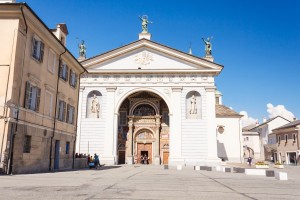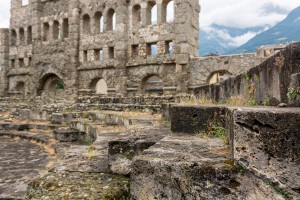
©Bigstock.com/terrabattuta
Aosta Valley is located in the outermost northwest of Italy, bordering on France and Switzerland. The small region is known for its natural beauty and tourism, the numerous regional and national parks, and the prestigious, mostly cross-border ski regions. In addition, Aosta Valley’s municipalities’ names are French – a pointer to the more than 900-year-long affiliation with the dominion of the House of Savoy. However, only few outside the regional borders know the names of the individual villages. The capital Aosta – the only place in Aosta Valley with an additional Italian name – actually is a genuine city of arts with its highly fascinating history and enthralling sights. Time to take a closer look at this somewhat hidden and wrongly overlooked gem in the north of Italy.
How Aosta became Aosta
The site of today’s capital of Aosta Valley used to accommodate prehistoric settlements some 5,000 to 6,000 years ago. The native Salassi managed to fight off Roman invaders for a long time thanks to the natural alpine barrier. Eventually, A. Terentius Varro Murena conquered Aosta Valley in 25 BC. Most of the Salassi were sold as slaves. Augustus had the city Augusta Prætoria founded on the site of an existing camp of the Roman legion.
You can still see the original Roman chequerboard pattern in the old town of Aosta. 64 residential blocks (insulae) formed Augusta Prætoria, surrounded by a massive city wall with one gate each on all four sides. Larger structures were built on pre-defined “chequerboard squares”. The Franks and the Lombards fought over the territory after the fall of the Roman Empire, Charlemagne later had the Via Francigena to Rome built through the city. Humbert I, Count of Savoy purchased the region in 1025; it remained part of the Savoy dominion until 1946, even after its incorporation into the Italian Kingdom in 1861. Fascist reign forced Italianisation on Aosta Valley making it one of the leading centres of resistance during World War II. The region received special autonomous status in order to counteract self-governing efforts as well as annexation plans by France. To this day nearly 80% of the population speak French. Nearly 70% speak the traditional Franco-Provençal dialect.
Prehistoric Aosta
We suggest working your way through the many facets of Aosta chronologically, which is why we are kicking things off in prehistoric times. Saint Martin de Corléans on the western outskirts is one of Italy’s largest megalithic areas. It was discovered in June 1969 and excavated in 22 different layers with a depth of up to six metres and carefully analysed. Experience the evolution of this site from the end of the Neolithic Age to the Copper Age and Iron Age and, eventually, the Iron Age on a total area of approx. six hectares. Experts believe that the oldest phase of human activity began around 4200 BC. Ploughed crenation suggests ritual acts. The actual construction of the megalithic area likely started somewhere between 3000 and 2750 BC. 22 in-row timber piles – believed to be totems by experts – were installed, more than 40 anthropomorphic steles would follow. They are presumably festive monuments honouring heroes and gods. Saint Martin de Corléans is also a necropolis. The sepultural period lasted into the Bronze Age with various types of tombs and rites having been identified. Some finds suggest that the necropolis was even used until the Roman conquest. A humongous museum complex across two buildings grants you fascinating insights into the excavation site. Here you learn more about the various archaeological stages and the evolution of Aosta, then as now.
Roman ruins in Aosta

©Bigstock.com/Bizi88
As previously mentioned, you can still see the Roman layout of Aosta when strolling through its old town. Some buildings and structures from ancient times actually survived, at least partially. The Roman city walls of Aosta are certainly something special. Medieval rulers continued to use them, which is probably why they still are almost entirely intact. The walls enclose a rectangular area of 724 x 572 metres and, for the most part, exceed heights of six metres. Furthermore, the eastern and southern gates survived as well. The main gate Porta Prætoria, built in the 1st century AD, was later covered with marble while otherwise mostly retaining its original form. The Arch of Augustus in front of the gate and the Roman bridge Pont de Pierre that originally crossed a river also date back to this period.
However, not all buildings are quite as well-preserved. While some of the city wall towers are still Roman at their core, many experienced comprehensive alternations. Picking a fairly prominent example, the Tower of Bramafam was built on the ruins of a Roman bastion in the 11th century and served as the residence of the viscount of the House of Savoy. In other Roman news, only the south wall of the monumental, four-storey theatre survived, and the forum is mostly gone as well. Do not miss out on a trip to the Roman estate on the hill above Aosta, though!
Other sights in Aosta
But that is certainly not all that Aosta, the city of arts, has in store for you. It goes without saying that the centuries after the end of the Roman rule left their marks on the capital of Aosta Valley as well. As such, we warmly recommend the following highlights:
- Cathedral: Cattedrale di Aosta was originally built in the 4th century but disappeared about 700 years later to make way for a new building. Even more modifications took place during the 15th and the 16th The late Gothic look, the Renaissance façade, the neoclassical porch of later years in combination with the mosaic floor and the glass paintings from the 12th and the 13th century create an astonishingly spectacular architectural mix.
- Sant’Orso: The roots of this former collegiate church, too, can be traced much further back as well – to the 5th century, if we are being precise. A full early Romanesque rebuilding eventually made way for today’s late Gothic look during the 15th While the five-nave crypt built on twelve Roman pillars carries an air of the preceding building, the cycle of frescoes depicting scenes from the life of Christ and his apostles is deeply immersed in 11th century tradition.
- Ponte di Grand Arvou: Increased populating of Aosta Valley, combined with livestock breeding, led to water supply shortages. The Rû Prévôt Canal was built during the 13th and the 14th century, numerous aqueducts followed. Among the most splendid structures of this initiative is Ponte di Grand Arvou which, by the way, is still operational.
- Riserva naturale Tzatelet: One of the region’s most beautiful nature reserves is situated a bit outside Aosta. See many rare bird species and the diverse Mediterranean vegetation, an absolute rarity for the Alps. Another Neolithic necropolis, presumably established around 3000 BC, was found on the Tzatelet hill.
While there definitely are better-known cities than Aosta in Northern Italy, you absolutely must not miss out on the capital of Aosta Valley. The gripping historic heritage of the regional capital from time immemorial to the Roman Empire to the late Gothic period unearths many a hidden treasure deserving of a closer look. Explore this alpine gem, best combined with a certainly unforgettable hiking or skiing holiday in the surrounding mountains.